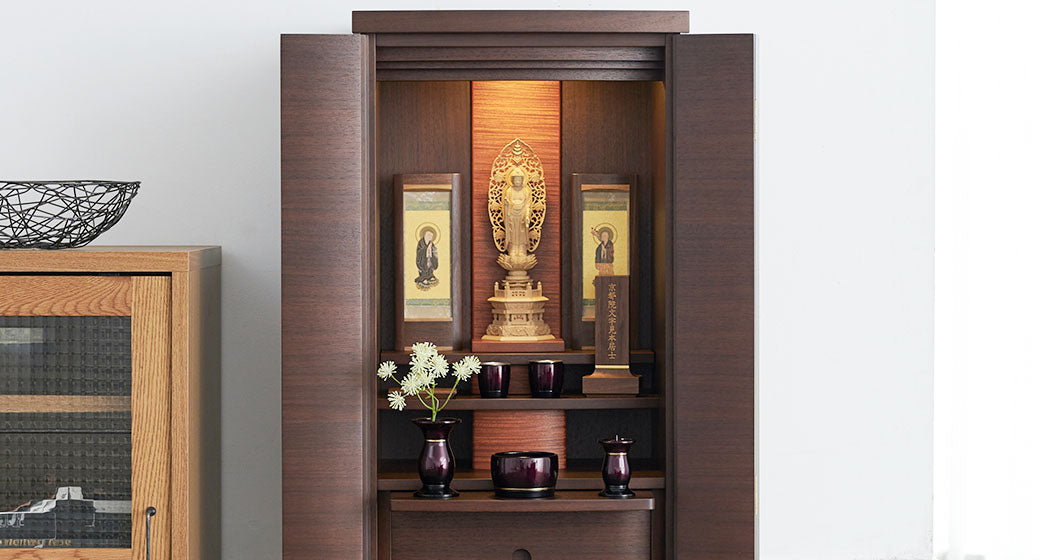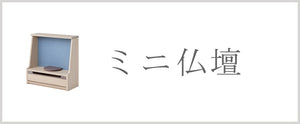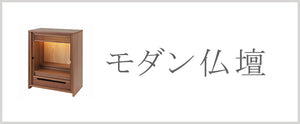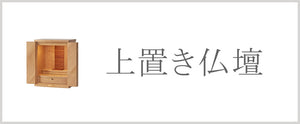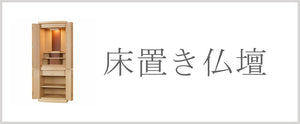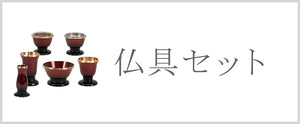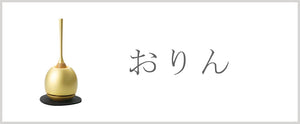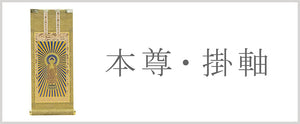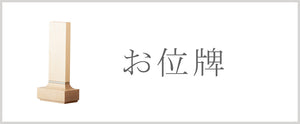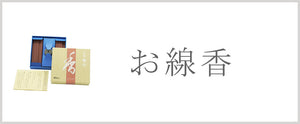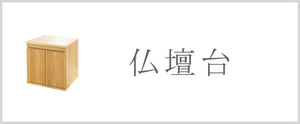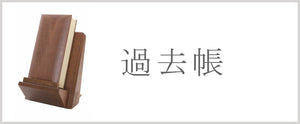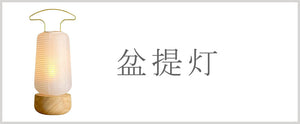Last updated:
Release date:
There are two types of principal image placed in the center of the Buddhist altar: a Buddhist statue and a hanging scroll.
Some people may wonder what the difference is between a Buddhist statue and a hanging scroll, and which is better to display.
In this article, we will explain the differences between Buddhist statues and hanging scrolls.
Which is better: a Buddhist statue or a hanging scroll?
Both Buddhist statues and hanging scrolls have the same role in that they are objects of worship as principal images.
Once the temple has performed the soul-infusing ceremony (soul-infusing and eye-opening ceremony), both are equally enshrined in the Buddhist altar.
Therefore, neither is better than the other.
When actually choosing, it is a good idea to consider the following characteristics of each altar, and also check the shape, size, and depth of your home altar.
Buddhist statue
- The light from the Buddhist altar creates shadows, creating a more solemn atmosphere.
- It is heavier and more imposing than a hanging scroll.
- Many of them are intricately crafted, so care is required when caring for them.
- They tend to be more expensive than hanging scrolls.
merit
Disadvantages
hanging scroll
- It can be placed even in places with little depth (it goes well with mini Buddhist altars, etc.)
- They are easier to care for than Buddhist statues (some types are particularly easy to care for, such as stand-type hanging scrolls in acrylic frames).
- Many of them are made of paper or cloth, and are more susceptible to damage over time than Buddhist statues.
- Depending on the materials used and how they are maintained, repairs may not be possible and replacement may be necessary.
merit
Disadvantages
So it's a good idea to choose based on the characteristics of each.
Officially, the principal image is placed in the center, with three attendant statues on either side, but recently it has become common to place only the principal image, which is the centerpiece of faith.
The principal image is a Buddha statue, and both sides are hanging scrolls. Or, in many cases, all three are hanging scrolls.
However, in the case of Jodo Shinshu (Jodo Shinshu Honganji-ha, Shinshu Otani-ha), hanging scrolls are recommended at head temples.
If you are a Jodo Shinshu sect sect member but would like to display a Buddhist statue, it is a good idea to consult with your family temple in advance and then communicate your wishes to the Buddhist altar store.
Types of Buddhist statues and their placement
There are Buddhist statues made of wood and resin.
The main wooden materials are cypress, boxwood, camphor, and sandalwood.
Prices vary depending on the rarity of the wood and the intricacy of the carving and workmanship.
There are unpainted pieces that allow the natural texture of the wood to shine through, and pieces that are finished with gold leaf and coloring.
The most common type of resin is gold painted.
There are no hard and fast rules about size.
However, it is best to choose one that allows you to clearly see the Buddha's face when you put your hands together.
It is also standard to place it on the highest shelf of the Buddhist altar.
In particular, if the principal image is a Buddha statue and the two attendants are hanging scrolls, make sure that the position of the face of the monk depicted on the hanging scroll is not higher than the face of the Buddha statue (principal image) when the scroll is hung.
Also, when choosing a Buddhist statue, you should pay attention to the height of the interior of the altar.
This is because Buddhist statues have halos (lights around the back), so they need to be tall enough.
When placing a Buddhist statue in the altar, it is important to check that its face is not hidden by the transom .
Some types of Buddha statues have great depth.
If you are prioritizing the presence of a Buddhist statue in your Buddhist altar, it will be easier to display it if you choose a traditional gold Buddhist altar, a traditional wood Buddhist altar, or a modern Buddhist altar that has ample height and depth, or one with removable internal shelves.
Types of hanging scrolls and how to place them
There are a wide variety of hanging scrolls.
There are various types of hanging scrolls available, including those with images of Buddha printed on them and those hand-painted by artisans, and they come in a wide range of prices.
Among them are expensive hanging scrolls made with carefully selected materials, such as "kenpon," a plain weave of raw silk, and those mounted in genuine gold brocade.
However, in recent years, modern Buddhist altars that fit easily into Western-style housing environments have become popular, and hanging scrolls that match these have also become more common.
In the past, hanging scrolls were attached directly to the back of the altar with rivets, but recently it has become more common to hang the scroll on a "hanging scroll stand" and place it inside the altar without drilling holes in the back.
Stand-type hanging scrolls that are integrated with the supporting part are also now available.
When choosing a hanging scroll, it is also important to check the size.
The unit of measurement for hanging scrolls is called "dai," and depending on the type, there is a wide range of values, from 20s to 300s.
Additionally, many Buddhist altar stores now carry sizes known as "mamedai" for those in their 20s or younger, so even if you have a small Buddhist altar, there is sure to be a size that suits you.
In addition, in Jodo Shinshu, hanging scrolls called "homyojiku" are also displayed on Buddhist altars.
A posthumous name scroll has the posthumous name (kaimyo) of the deceased and the date of death written on it, and has a different function from a hanging scroll, which is an object of worship, so be careful not to confuse the two.
Types of hanging scrolls and how to place them
Both the Buddhist statues and hanging scrolls are enshrined as principal images and are the cornerstone of faith.
Basically, there is no rule that says you have to use either one, so check the shape and size of your Buddhist altar and choose the one that best suits your requirements.
Nagomi Kobo TOP page is here >
